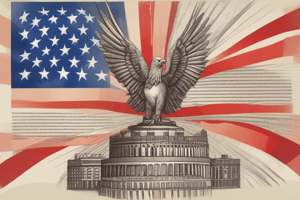Podcast
Questions and Answers
What do state constitutions establish?
What do state constitutions establish?
Branches of government
What system is the United States built on?
What system is the United States built on?
Federal system
What system of government is developed by each state?
What system of government is developed by each state?
Own checks and balances
What type of government are state governments established as?
What type of government are state governments established as?
What are the three branches of state governments?
What are the three branches of state governments?
In a republic, people elect representatives to speak on their behalf.
In a republic, people elect representatives to speak on their behalf.
The structure of state governments are determined by _________________.
The structure of state governments are determined by _________________.
Who leads the Executive Branch of a state?
Who leads the Executive Branch of a state?
What role does the Attorney General serve?
What role does the Attorney General serve?
What is the typical name for the Upper House in state legislatures?
What is the typical name for the Upper House in state legislatures?
What are the usual characteristics of the Lower House?
What are the usual characteristics of the Lower House?
What issues are handled by state governments?
What issues are handled by state governments?
What is one responsibility of state governments regarding elections?
What is one responsibility of state governments regarding elections?
What is included in a state's responsibility for infrastructure?
What is included in a state's responsibility for infrastructure?
Flashcards are hidden until you start studying
Study Notes
State Government Overview
- Each state has its own written constitution outlining the structure and interaction of government branches.
- The United States operates under a federal system where state governments manage their own affairs.
Checks and Balances
- Each state develops its own system of checks and balances to ensure equitable governance.
Structure of State Governments
- State governments are designed as republics, adhering to constitutional guidelines that mandate representative bodies.
- Branches of state governments include the Executive, Legislative, and Judicial.
Executive Branch
- The Executive Branch is led by a governor, elected by citizens, who serves as the chief executive of the state.
- State governors have varying term limits, with some allowed multiple terms and others restricted to a set number.
Executive Leaders
- Citizens usually elect executive department leaders, contrasting with the federal level where leaders are appointed.
- Key executive roles include:
- Lieutenant Governor: Acts as second in command within the executive branch.
- Attorney General: Functions as the state's lawyer.
- Secretary of State: Oversees state agencies and elections.
- Agency and Department Heads: Manage various state agencies.
Legislative Branch
- Each state has its own legislature responsible for making laws and approving budgets.
- Most state legislatures consist of two houses: an upper house (often the Senate) and a lower house (usually the House of Representatives).
Legislative Structure
- The upper house is typically smaller, serving longer terms (often four years), while the lower house is larger with shorter terms (usually two years).
Judicial Branch
- State judicial systems consist of multiple levels to interpret laws, including local courts, appellate courts, and a state high court (or supreme court).
- Local courts hear cases and facilitate justice at a community level, while appellate courts handle appeals from lower courts.
Key Functions of State Governments
- State governments manage critical issues:
- Infrastructure: Responsible for construction, repair of roads, and maintenance of public transport systems.
- Elections: Organize and conduct local, state, and national elections, including voter registration and polling operations.
- Education: Create and maintain educational systems, including school districts and state educational standards.
- Public Health and Safety: Ensure public safety protocols and health measures are in place for state residents.
Studying That Suits You
Use AI to generate personalized quizzes and flashcards to suit your learning preferences.




